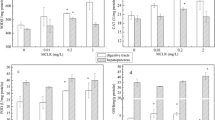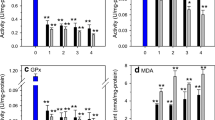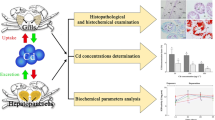Abstract
The acute toxicity of Cd was tested, and metal bioaccumulation in tissue was determined for the alien invasive species Pomacea canaliculata and its native competitor Sinotaia quadrata under experimental conditions. The invasive species was more tolerant to Cd toxicity than native species, for which the LC50 values were 4.26, 2.24, and 1.98 mg/L at exposure times of 48, 72, and 96 h, respectively, approximately three times higher than those of the native snails. The viscera accumulated the highest Cd concentration, followed by the foot and shell in both species. Metal concentrations in the above three tissues of P. canaliculata were much higher than those of S. quadrata, irrespective of Cd dose and exposure time. For P. canaliculata, the highest concentration of metal was further observed in the hepatopancreas (0.64–3.98 mg/g) followed by the kidney (0.067–3.78 mg/g), with lowest levels in the stomach (0.062–1.53 mg/g). Among the five antioxidant enzymes, the most responsive enzymes were CAT, ALP, and GST in the hepatopancreas; CAT, POD, and GST in the kidney; and POD in the stomach of exposed animals. These results, demonstrating a high Cd tolerance, may partly explain the ability of P. canaliculata to displace S. quadrata in Cd-contaminated habitat. The Cd was accumulated mainly in the hepatopancreas and kidney of invasive species, which changed the activity of antioxidant enzymes allowing the animals to cope with the toxicity.

Cadmium bioaccumulation and antioxidant enzyme activity in the invasive Pomacea canaliculata.





Similar content being viewed by others
References
Abdel-Halim KY, Abo EI-Saad AM, Talha MM, Hussein AA, Bakry NM (2013) Oxidative stress on land snail Helix aspersa as a sentinel organism for ecotoxicological effects of urban pollution with heavy metals. Chemosphere 93:1131–1138
Alonso Á, Castro-Díez P (2008) What explains the invading success of the aquatic mud snail Potamopyrgus antipodarum (Hydrobiidae, Mollusca)? Hydrobiologia 614:107–116
Amiard JC, Amiard-Triquet C, Barka S, Pellerin J, Rainbow PS (2006) Metallothioneins in aquatic invertebrates: their role in metal detoxification and their use as biomarkers. Aquat Toxico l76:160–202
Barata C, Varob I, Navarro JC, Arun S, Porte C (2005) Antioxidant enzyme activities and lipid peroxidation in the freshwater cladoceran Daphnia magna exposed to redox cycling compounds. Comp Biochem Physiol C 140:175–186
Bielen A, Bošnjak I, Sepčić K, Jaklič M, Cvitanić M, Lušić J, Lajtner J, Simčič T, Hudina S (2016) Differences in tolerance to anthropogenic stress between invasive and native bivalves. Sci Total Environ 543:449–459
Boets P, Lock K, Goethals PLM, Janssen CR, De Schamphelaere KA (2012) A comparison of the short-term toxicity of cadmium to indigenous and alien gammarid species. Ecotoxicology 21:1135–1144
Bowers GN, McComb RB (1996) Clin Chem 12:70–75
Boshoff M, Jordaens K, Backeljau T, Lettens S, Tack F, Vandecasteel B, De Jonge M, Bervoets L (2013) Organ- and species- specific accumulation of metals in two land snail species (Gastropoda, Pulmonata). Sci Total Environ 449:470–481
Cabecinhas AS, Novais SC, Santos SC, Rodrigues AC, Pestana JL, Soares AM, Lemos MF (2015) Sensitivity of the sea snail Gibbula umbilicalis to mercury exposure-linking endpoints from different biological organization levels. Chemosphere 119:490–497
Chen GW, Ma KX, Liu DZ (2013) Changes of alkaline phosphatase activity in response to different stressors in planarian Dugesia japonica. Biologia 68:264–268
Chen MH, Soong K (2002) Estimation of age in the sex-changing, coral-inhabiting snail Coralliophila violacea from the growth striae on opercula and a mark-recapture experiment. Mar Biol 140:337–342
Cresswell T, Simpson SL, Mazumder D, Callaghan PD, Nguyen AP (2015) Bioaccumulation kinetics and organ distribution of cadmium and zinc in the freshwater decapods crustacean Macrobrachium australiense. Environ Sci Technol 49:1182–1189
Dang F, Wang WX (2009) Assessment of tissue-specific accumulation and effects of cadmium in a marine fish fed contaminated commercially produced diet. Aquat Toxicol 95:248–255
Das K, De Groof A, Jauniaux T, Bouquegneau JM (2006) Zn, Cu, Cd and Hg binding to metallothioneins in harbor porpoises Phocoena phocoena from the southern North Sea. BMC Ecol 6:2
Das S, Khangarot BS (2010) Bioaccumulation and toxic effects of cadmium on feeding and growth of an Indian pond snail Lymnaealuteola L. under laboratory conditions. J Hazard Mater 182:763–770
Dummee V, Tanhan P, Kruatrachue M, Damrongphol P, Pokethitiyook P (2015) Histopathological changes in snail, Pomacea canaliculata, exposed to sub-lethal copper sulfate concentrations. Ecotoxicol Environ Saf 122:290–295
El-Shenawy NS, Mohammadden A, Al-Fahmie ZH (2012) Using the enzymatic and non-enzymatic antioxidant defense system of the land snail Eobania vermiculata as biomarkers of terrestrial heavy metal pollution. Ecotoxicol Environ Saf 84:347–354
Giraud-Billoud M, Vega IA, RinaldiTosi MER, Abud MA, Calderón ML, Castro-Vazquez A (2013) Antioxidant and molecular chaperone defences during estivation and arousal in the South American apple snail Pomacea canaliculata. J Exp Biol 216:614–622
Hayes KA, Joshi RC, Thiengo SC, Cowie RH (2008) Out of South America: multiple origins of non-native apple snails in Asia. Diversity Distrib 14:701–712
Hispard F, Schuler D, de Vaufleury A, Scheifler R, Badot PM, Dallinger R (2008) Metal distribution and metallothionein induction after cadmium exposure in the terrestrial snail Helix aspersa (Gastropoda, Pulmonata). Environ Toxicol Chem 27:1533–1542
Hoang TC, Rogevich EC, Rand GM, Frakes RA (2008) Copper uptake and depuration by juvenile and adult Florida apple snails (Pomacea paludosa). Ecotoxicology 17:605–615
Hoang TC, Pryor RL, Rand GM, Frakes RA (2011) Bioaccumulation and toxicity of copper in outdoor freshwater microcosms. Ecotoxicol Environ Saf 74:1011–1020
Hu Y, Mu X, Luo D, Xu M, Yang Y, Gu D (2014) Genetic variability of the invasive snail Pomacea canaliculata in South China based on mitochondrial 16S rDNA sequences. Biochem Syst Ecol 57:203–209
Kwong KL, Dudgeon D, Wong PK, Qiu JW (2010) Secondary production and diet an invasive snail in freshwater wetlands: implications for resource utilization and competition. Biol Invasions 12:1153–1164
Larba R, Soltani N (2014) Use of the land snail Helix aspersa for monitoring heavy metal soil contamination in Northeast Algeria. Environ Monit Assess 186:4987–4995
Laskowski R, Hopkin SP (1996) Accumulation of Zn, Cu, Pb and Cd in the graden snail (Helix aspersa): implication of predators. Environ Pollut 91:289–297
Le DQ, Nguyen DC, Harino H, Kakutani N, Chino N, Arai T (2010) Distribution of trace metals and methylmercury in soft tissues of the freshwater eel Anguilla marmorata in Vietnam. Arch Environ Contam Toxicol 59:282–290
Li CC, Dang F, Cang L, Zhou DM, Peijnenburg WJGM (2015) Internal distribution of Cd in lettuce and resulting effects on Cd trophic transfer to the snail: Achatina fulica. Chemosphere 135:123–128
Mleiki A, Irizar A, Zaldibar B, El Menif NT, Marigómez I (2016) Bioaccumulation and tissue distribution of Pb and Cd and growth effects in the green garden snail, Cantareus apertus (Born, 1778), after dietary exposure to the metals alone and in combination. Sci Total Environ 547:148–156
Moolman L, Van Vuren JHJ, Wepener V (2007) Comparative studies on the uptake and effects of cadmium and zinc on the cellular energy allocation of two freshwater gastropods. Ecotoxicol Environ Saf 68:443–450
Morrison WE, Hay ME (2011) Feeding and growth of native, invasive and non-invasive alien apple snails (Ampullariidae) in the United States: invasives eat more and grow more. Biol Invasions 13:945–955
Ng TYT, Pais NM, Wood CM (2011) Mechanisms of waterborne Cu toxicity to the pond snail Lymnaea stagnalis: physiology and Cu bioavailability. Ecotoxicol Environ Saf 74:1471–1479
Notten MJ, Oosthoek AJ, Rozema J, Aerts R (2006) Heavy metal pollution affects consumption and reproduction of the land snail Cepaea nemoralis fed on naturally polluted Urtica dioica leaves. Ecotoxicology 15:295–304
Oliveira P, Lopes-Lima M, Machado J, Guilhermino L (2015) Comparative sensitivity of European native (Anodont aanatina) and exotic (Corbicula fluminea) bivalves to mercury. Est Coast Shelf Sci 167:191–198
Peña SC, Pocsidio GN (2007) Influence of copper on the feeding rate, growth and reproduction of the golden apple snail, Pomacea canaliculata Lamarck. Bull Environ Contam Toxicol 79:606–608
Piola RF, Johnston EL (2009) Comparing differential tolerance of native and non-indigenous marine species to metal pollution using novel assay techniques. Environ Pollut 157:2853–2864
Piyatiratitivorakul P, Ruangareerat S, Vajarasathira B (2006) Comparative toxicity of heavy metal compounds to the juvenile golden apple snail, Pomacea sp. Fresenius Environ Bull 15:379–384
Raimi OG, Fatai AA, Bankole HA, Olaitan SN, Fajana OO, Kazeem MI, Akobada KA (2011) Characterization of alkaline phosphatase (E.C.3.1.3.1) from giant African snail (Archachatina marginata). J Cell Tissue Res 11:2485–2489
Reátegui-Zirena EG, French AD, Klein DM, Salice CJ (2017) Cadmium compartmentalization in the pulmonate snail Lymnaea stagnalis: improving our understanding of exposure. Arch Environ Contam Toxicol 72:575–585
Roméo M, Gharbi-Bouraoui S, Gnassia-Barelli M, Dellali M, Aïssa P (2006) Responses of Hexaplex (Murex) trunculus to selected pollutants. Sci Total Environ 359:135–144
Schneiker J, Weisser WW, Settele J, Bustamante JV, Marquez L, Villareal S, Türke M (2016) Is there hope for sustainable management of golden apple snails, a major invasive pest in irrigated rice? Njas-Wagen J Life Sci 79:11–21
Sharaf HM, Salama MA, Abd EI-Att MS (2015) Biochemical and histological alterations in the digestive gland of the land snail Helicella vestalis (Locard, 1882) exposed to methiocarb and chlorpyrifos in the laboratory. Internat J Sci Res 4:324–343
Vega IA, Arribére MA, Almonacid AV, Guevara SR, Castro-Vazquez A (2012) Apple snails and their endosymbionts bioconcentrate heavy metals and uranium from contaminated drinking water. Environ Sci Pollut Res 19:3307–3316
Wang W, Wu X, Liu Z, Liu Z, Zheng H, Cheng Y (2014) Insights into hepatopancreatic functions for nutrition metabolism and ovarian development in the crab Portumus trituberculatus: gene discovery in the comparative transcriptome of different hepatopancreas stages. PLoS One 9:e84921
Xu M, Fang M, Yang Y, Dick JT, Song H, Luo D, Hu Y (2016) Spatial variation in adult sex ratio across multiple scales in the invasive golden apple snail, Pomacea canaliculata. Ecol Evol 6:2308–2317
Zhang J, Xie Z, Wang Z (2016) Oxidative stress responses and toxin accumulation in the freshwater snail Radix swinhoei (Gastropoda, Pulmonata) exposed to microcystin-LR. Environ Sci Pollut Res 23:1353–1361
Funding
This research was financially supported by the National Natural Science Foundation of China (Nos. U1131006, 30770403, and 41501338), the Science and Technology Program of Guangdong Province (No. 2015B090903077), the National Key Research and Development Program of China (2017YFD0801000), and the Natural Science Foundation of Guangdong Province (2014A030310320).
Author information
Authors and Affiliations
Corresponding author
Additional information
Responsible editor: Philippe Garrigues
Rights and permissions
About this article
Cite this article
Huang, F., Peng, L., Zhang, J. et al. Cadmium bioaccumulation and antioxidant enzyme activity in hepatopancreas, kidney, and stomach of invasive apple snail Pomacea canaliculata. Environ Sci Pollut Res 25, 18682–18692 (2018). https://doi.org/10.1007/s11356-018-2092-1
Received:
Accepted:
Published:
Issue Date:
DOI: https://doi.org/10.1007/s11356-018-2092-1




